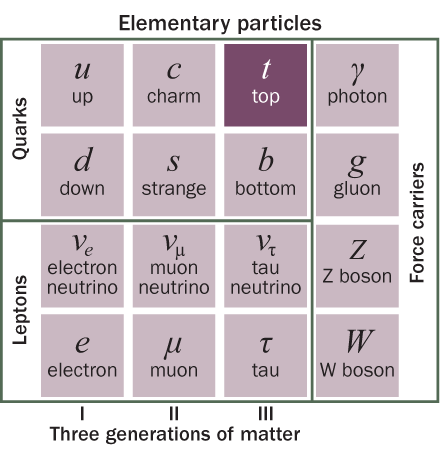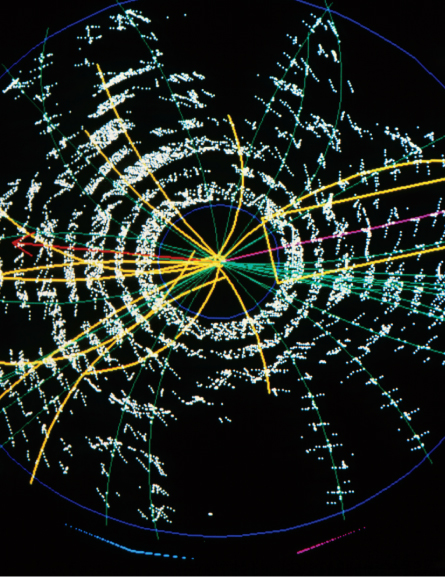The most powerful atom smasher in the United States will soon smash no more.



Known as the Tevatron, this 6.3-kilometer subterranean ring was once the biggest, baddest physics machine in the world. For 26 years it has been slamming together bits of matter and antimatter moving at nearly the speed of light. These violent collisions spit out new particles never before seen by humankind, revealing some of nature’s deepest secrets.
Yet for all its past achievements, the Tevatron’s time has come. Facing a tight budget, the U.S. Department of Energy will shutter the aged machine on September 30 (SN: 2/12/11, p. 5).
A more powerful machine will continue the task of probing the universe at ever-smaller scales: the Large Hadron Collider, or LHC, at CERN near Geneva.
“Other people have had to turn off their colliders for the same reason that we’re having to turn ours off now: There’s a bigger, better game in town,” says Steve Holmes of the Fermi National Accelerator Laboratory in Batavia, Ill., the preeminent particle physics lab in the United States and home to the Tevatron.
But even after the Tevatron has been embalmed, its liquid helium lifeblood drained away, the work won’t be done. Some Fermilab scientists will spend months, others years, digging through the pile of information left behind: about a million billion recorded collisions between protons and their antimatter counterparts, antiprotons.
“Now that we’re stopping taking data, we can concentrate all of our energy on updating our analyses,” say Giovanni Punzi, a spokesman for the Tevatron’s Collider Detector at Fermilab, or CDF, and a physicist at the University of Pisa and the National Institute of Nuclear Physics in Italy.
Some scientists believe the condemned machine still has something to say about the Higgs boson. This particle, whose existence would confirm the mechanism thought to give mass to other particles, has never been caught in action. With the LHC now the uncontested front-runner for this discovery, the Tevatron may still be able to help by narrowing the search, playing Horatio to the LHC’s Hamlet.
Peculiar sightings reported by Fermilab scientists over the last few years will also be investigated, anomalies difficult to explain with the laws of nature as they are currently understood. If confirmed, such oddities could hint at new and exotic physics.
Sheer manpower may ultimately limit what can be found; every day, more physicists switch to other projects, including heading to the LHC. But extracting every last bit of science from the remaining data could add a final postscript to the Tevatron’s legacy.
Higgs hunt
Every collision recorded at the Tevatron during its lifetime has the potential to surprise. Each smashup between a proton and an antiproton can create additional particles that break down into spectacular showers of debris. Two detectors at distant points along the Tevatron ring, CDF and another called DZero, record the energies and trajectories of these pieces of subatomic flotsam.
Working backward from this debris can reveal ephemeral particles that don’t live long enough to be seen directly. One such particle is the Higgs. No one really knows what the Higgs looks like, but the most popular version would break down into a pair of quarks, fundamental particles that make up larger entities such as protons and neutrons. The pair of quarks expected from the Higgs — a bottom quark and its antimatter partner — would in turn decay into jets of still other particles visible to the Tevatron.
As with Bigfoot, though, one snapshot isn’t enough to claim discovery. Despite upgrades over the years, the Tevatron hasn’t produced enough collisions to definitively rule out statistical flukes, random fluctuations that could mimic the Higgs.
“Discovering the Higgs boson has always been a really long shot for the Tevatron,” says Chris Quigg, a theoretical physicist at Fermilab.
With the details of the Higgs still unknown, the Tevatron could help rule out some possible masses for the particle, though. Statistically speaking, it’s easier to show what isn’t than to show what is.
In July the Tevatron eliminated a sizable swath of possible masses. Previous work had put the mass of the Higgs particle somewhere between 114 billion and 185 billion electron volts, or GeV. (Particle physicists measure mass in energy, relying on Einstein’s E=mc2.) The new analysis, which included about 80 percent of the total data expected to be collected before shutdown in September, ruled out 156 to 177 GeV with 95 percent confidence.
Still newer results from the LHC have given the Higgs even less space in which to hide. If the Higgs is the version most physicists expect, it should have a mass less than 145 GeV, researchers reported in August in Mumbai at a high-energy physics meeting.
Whether the Tevatron can winnow away more of the remaining range with its full dataset remains to be seen. Both the LHC and the Tevatron have spotted the faintest hints of something Higgs-like below about 145 GeV. If either the Tevatron or the LHC’s data rule out this region, more exotic versions of the Higgs will need to be considered.
“We expect to complete our Higgs analysis by March,” says Fermilab’s Rob Roser.
Standard model defender
The Higgs is only one piece of a much larger puzzle called the standard model of particle physics. Stitched together in the 1970s from earlier theories, this modestly named cornerstone of modern physics uses 16 elementary particles to explain most of the clockwork that keeps the universe ticking, with the notable exception of gravity.
Throughout its long history, the Tevatron has risen to defend the standard model again and again. The collider discovered a host of particles predicted by the model — both a fundamental particle and larger ones built of the fundamental units — filling in the blanks of subatomic family trees. Some of these particles still haven’t been seen anywhere else: certain baryons — composite particles made of three quarks — for instance (SN: 9/27/08, p. 7; SN: 8/27/11, p. 14).
“The Tevatron really helped to establish how good the standard model is,” says physicist Frank Wilczek of MIT, who won a Nobel Prize for his contributions to the model. “It’s much better than we anticipated in the early days.”
In 1995 the Tevatron discovered the top quark, the last of the standard model’s six quarks to be spotted. Physicists had expected to find the particle after a 1977 Fermilab experiment turned up evidence for the bottom quark, a particle that needed a partner. But machines built specifically to search for that partner — the TRISTAN detector in Japan, for instance — were striking out. The problem, scientists began to realize, was the top quark’s bizarre mass. It weighs almost as much as an entire atom of gold.
“The top quark turned out to be much heavier than we originally thought,” says Meenakshi Narain, a particle physicist at Brown University in Providence, R.I., who helped discover it.
Such a heavy particle could be created only by the high-energy collisions of the Tevatron, which reach almost 2 trillion electron volts. That’s about twice the energy due to motion of a flying mosquito in an area a trillionth as big. Only Fermilab physicists have measured the mass of this particular quark, a measurement repeated with ever-greater precision over the years.
Adding more numbers to the right of a decimal point may not sound as sexy as discovering a new particle. But knowing these masses precisely helps to calibrate the mathematical machinery of the standard model, which doesn’t predict the masses of particles by itself. Tevatron measurements of the heaviness of the top quark and another particle called the W boson provided an important indirect limit on the Higgs mass, before those indirect measurements were trumped by the LHC’s latest data.
The Tevatron’s unflagging support of the standard model, though, has also been a source of great disappointment. Physicists need something beyond this framework, something that can explain why the Higgs, if discovered, has the mass it does. Extra dimensions beyond the four that people experience as space and time have been proposed, as has a new kind of symmetry hidden in the universe.
Many had hoped that the Tevatron would reveal signs of this “supersymmetry,” one of the most popular extensions of the standard model. According to supersymmetry, every particle has a shadowy twin that differs in a quantum property called spin.
But no evidence of these extra particles has turned up. If such particles exist, they probably have high masses and can be produced only in the higher-energy collisions possible at the LHC.
“There are all these unrealized hopes,” says Michael Peskin, a theoretical physicist at SLAC National Accelerator Laboratory in Menlo Park, Calif. “They didn’t find any new interactions beyond the interactions included in the standard model.”
Hand-wringing hints
While it’s true that no Tevatron claims of physics beyond the standard model have been verified, some strange but inconclusive anomalies have popped up in the collider’s final years. These hints, some of which have already been challenged by other measurements at the Tevatron and elsewhere, have physicists wringing their hands and pulling their hair.
The Tevatron isn’t the first particle collider to tantalize scientists at the end of its days. In 2000, the Large Electron-Positron Collider at CERN found a strange signal in its data just before its shutdown. This blip at about 115 GeV was in the right range to be the Higgs, some argued. But the odds of a fluke were too high to claim a discovery, and the mysterious signal hasn’t been substantiated.
Fermilab physicists hope to fare better as they analyze their remaining data.
“When Columbus started his journey, he didn’t know he would discover America,” says Dmitri Denisov, a spokesman for DZero. “We’re just going and seeing what we can find.”
In 2008 CDF spotted pairs of particles behaving badly. Top quarks created in proton-antiproton collisions tended to move in the direction of the protons. Antitop quarks, the antimatter version of the top quark, generally moved back the other way.
A later look with more CDF data, about half of what will be collected by the end of September, only strengthened the statistics, and DZero has also reported this unexpected preference. The anomaly is too strong to square with the predictions of quantum chromodynamics, one of the theories rolled into the standard model.
A bookie taking bets that the CDF asymmetry is a fluke could post odds just shy of one in a thousand — about a “three sigma” result, in the language of physicists. That’s not good enough to say anything for sure, but it has stirred up some excitement.
“I find this forward-backward asymmetry tantalizing because both experiments saw it,” says Christopher Hill, a theoretical physicist at Fermilab.
Hill has an explanation for this unusual behavior, worked out in full mathematical detail by Harvard physicist Matthew Schwartz and colleagues in a paper posted online June 15 at arXiv.org. Two top quarks might behave like a pair of electrons in a superconductor, a material with no resistance to the flow of electricity. A new particle could unite the pair, which, in this theory, play the role of the Higgs by explaining the origin of mass.
Then again, adding in the full dataset could also wipe out this anomaly.
“We can’t make any claim yet, but we should have a more definitive look at this thing by next summer,” says Dan Amidei, a member of the CDF team and a physicist at the University of Michigan in Ann Arbor. “My greatest worry is not that it goes away with more data, but that it remains a hint and we never know what it was.”
Other curiosities on the table include jets of particles with energies between 120 and 160 GeV, which could be the remnants of a new, unexplained particle (not the Higgs). CDF saw the jets, but DZero didn’t. DZero, meanwhile, has uncovered an unexplained preference for the production of the matter version of the muon — an overweight cousin of the electron — over the antimatter version. This tricky measurement hasn’t been repeated by the CDF team.
Convincing the wider physics community that these oddities are real will be difficult. The LHC has already begun to investigate them; early results, presented in July at a meeting in Grenoble, France, contain no signs of anything out of the ordinary, contradicting the Tevatron results.
“I think they’re embarrassing rubbish,” says Wilczek, who favors supersymmetry as an extension of the standard model. “You really have to do contortions to make these things consistent with what we know, and I find it hard to believe that Mother Nature has such poor taste.”
Future frontiers
Even though the LHC is currently running at half its intended strength, that international machine will soon be the sole collider pushing the high-energy frontier in search of never-before-seen particles. No one else can compete with its collisions.
Without its famed atom smasher, Fermilab is shifting its focus to other areas, including the activities of already discovered particles. Next year, the lab will shut down temporarily to transplant some of the Tevatron’s bits and pieces into other experiments and to upgrade its accelerator complex for a new generation of experiments that require intense beams packed with tremendous numbers of particles, just not at such high energies.
Beams that once fed the Tevatron will be reconfigured to churn out muons for projects including Muon g-2. By examining the strange behavior of muons in magnetic fields, this project could point to certain versions of supersymmetry.
Other particles called neutrinos, loners that barely interact with the rest of matter, will become a centerpiece of particle physics in the United States, as well as in France, China and Japan. NOvA, an experiment under construction at Fermilab, will shoot beams of these particles 810 kilometers underground to a mine near the United States’ border with Canada. Understanding how neutrinos change from one kind to another during this trip could help to solve one of the biggest puzzles in physics: why the universe contains vastly more matter than antimatter.
Other big questions still remain for particle physicists at Fermilab and other institutions in the United States and around the world. Physicists don’t understand what the universe looked like in its first moments, for instance. No single theory has convincingly united gravity with nature’s other forces. And no one knows what dark matter and dark energy are, even though such invisible stuff appears to make up more than 95 percent of the universe’s mass-energy.
In the coming decades, a host of projects will tackle these big questions from different angles. With all its strength, even the LHC isn’t expected to have the final word. Already, scientists are planning for the next biggest, baddest physics machine.
TeV Legacy
The Fermi National Accelerator Laboratory, home to the Tevatron, has hosted a number of important discoveries over several decades.
 Credit: Fermilab/Photo Researchers, Inc.
Credit: Fermilab/Photo Researchers, Inc.
December 1966
Weston, Ill., selected as the site for the new National Accelerator Laboratory
March 1972
First proton beam with energies at 200 GeV, the target energy, circles the main ring
May 1974
NAL becomes Fermilab, named for Enrico Fermi
June 1977
Discovery of the bottom quark
July 1979
U.S. Department of Energy signs off on the building of a superconducting accelerator, later called the Tevatron
October 1985
First collisions of protons and antiprotons observed at the Tevatron’s Collider Detector at Fermilab, with energy of 1.6 TeV
March 1995
Discovery of the top quark (particle tracks shown) reported by both detectors
March 1999
Direct observation of CP violation in neutral kaons, suggesting not all particles and their antiparticles behave symmetrically
July 2000
First direct observation of the tau neutrino, the third neutrino type
June 2009
Observation of the Omega-sub-b baryon, an exotic and much heavier cousin of the proton
July 2011
Discovery of the neutral Xi-sub-b particle furthers scientific understanding of how quarks form other matter particles






